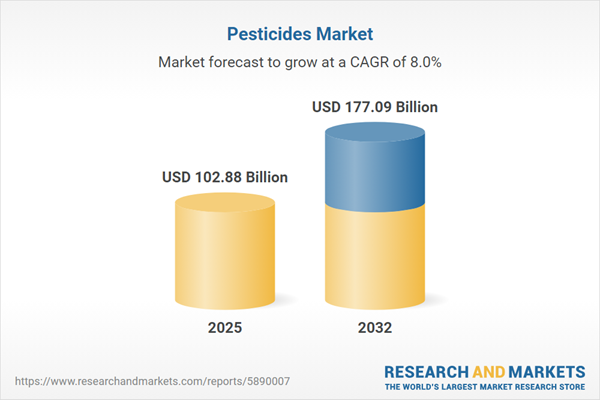Speak directly to the analyst to clarify any post sales queries you may have.
The pesticides market is evolving rapidly as stakeholders pivot toward sustainable, precision-driven pest management solutions. Decision-makers face new strategic imperatives prompted by regulatory, environmental, and technological shifts poised to reshape agricultural productivity globally.
Market Snapshot: Pesticides Industry Growth and Dynamics
The pesticides market grew from USD 95.53 billion in 2024 to USD 102.88 billion in 2025 and is projected to reach USD 177.09 billion by 2032, with a CAGR of 8.01%. This expansion is fueled by rising global food demand, increasing pest resistance, and the adoption of integrated pest management solutions. The industry is witnessing heightened investments in biological and synthetic pesticide innovation, while digital tools and stricter environmental regulations are fundamentally altering product development and application strategies.
Scope & Segmentation: Comprehensive Industry Coverage
This report assesses the pesticides market across a wide spectrum of product types, application techniques, and regional trends to provide actionable insights for senior leaders:
- Type: Fungicides such as azoxystrobin, chlorothalonil, fludioxonil; Herbicides including atrazine, glyphosate; Insecticides like carbamates, organophosphates, pyrethroids; Rodenticides for mammal pest control.
- Origin: Biopesticides (microbial pesticides, plant extracts), Synthetic pesticides developed using leading formulation science.
- Formulation: Liquid formulations, solid forms including granules and powders optimized for diverse field conditions.
- Mode of Application: Methods such as foliar spray, post-harvest treatment, seed and soil application designed for precision deployment.
- Crop Type: Cereals & grains (maize, rice, wheat), fruits & vegetables (apples, citrus, tomatoes), oilseeds & pulses (canola, soybean, sunflower), and turf & ornamentals for specialized applications.
- Sales Channel: Offline and online platforms to address varying procurement needs.
- Regions: Key focus on the Americas (United States, Canada, Brazil), Europe, Middle East & Africa (United Kingdom, Germany, South Africa, UAE), and Asia-Pacific (China, India, Japan, Australia, Southeast Asia).
- Company Analysis: Detailed profiles of market leaders such as Bayer AG, BASF SE, Syngenta AG, UPL Limited, Corteva Agriscience, Nufarm Limited, ADAMA, FMC Corporation, Albemarle Corporation, Sumitomo Chemical, and others, as well as emerging players in biopesticide innovation.
Key Takeaways for Senior Decision Makers
- Market strategy now demands a balance between productivity targets and ecological stewardship, as innovative solutions expand beyond broad-spectrum chemicals.
- Advances in genomics, digital monitoring, and nano-formulation are enabling data-driven, targeted interventions for higher return on investment and reduced off-target effects.
- Collaboration among research institutions, industry, and growers accelerates the development and adoption of integrated pest management and traceable, safe supply chains.
- Consumer and regulatory pressures are leading enterprises to demonstrate transparent sustainability practices and measurable residue reduction.
- Agility in supply chain management, supported by modular manufacturing and vertical integration, is now vital to respond to trade fluctuations and ensure continued market access.
Tariff Impact: Adapting to Shifts in Trade Policy
Tariff adjustments in the United States are reshaping input cost structures, driving companies to refine sourcing strategies, strengthen risk management, and develop supply chain alliances. Manufacturers with integrated operations and flexible procurement arrangements are better positioned to navigate the resulting shifts in cost and availability of key ingredients.
Pesticides Market Research Methodology & Data Sources
Research draws on primary data from over 50 senior executive interviews and insights from agronomists and regulatory experts. This is supported by secondary analysis using peer-reviewed journals, patent filings, official publications, and industry association data. Thorough data triangulation and subject matter expert validation ensure accurate and unbiased findings.
Why This Report Matters for B2B Leaders
- Build evidence-based strategies to address resistance, regulatory shifts, and sustainability in agrochemical investment portfolios.
- Access granular segmentation insights to identify growth opportunities by crop type, application technology, and geography.
- Strengthen competitive advantage by aligning operational agility and innovation with changing tariff and trade environments.
Conclusion: Shaping a Resilient, Sustainable Pesticides Market
Strategically navigating evolving regulations, leveraging technological advances, and fostering collaboration are crucial for sustaining growth in the pesticides market. Organizations that align innovation and sustainability will shape the future of resilient crop protection.
Additional Product Information:
- Purchase of this report includes 1 year online access with quarterly updates.
- This report can be updated on request. Please contact our Customer Experience team using the Ask a Question widget on our website.
Table of Contents
3. Executive Summary
4. Market Overview
7. Cumulative Impact of Artificial Intelligence 2025
Companies Mentioned
The companies profiled in this Pesticides market report include:- ABC Compounding Co., Inc.
- ADAMA Agricultural Solutions Ltd
- Albaugh, LLC
- Albemarle Corporation
- American Vanguard Corporation
- Arkema, Inc.
- Atul Limited
- BASF SE
- Bayer AG
- Corteva Agriscience, Inc
- FMC Corporation
- Nissan Chemical Corporation
- Nufarm Limited
- Sumitomo Chemical Co., Ltd.
- Syngenta AG
- UPL Limited
- Amico Pesticides
- Tyrone Agro Chemicals Pvt. Ltd
- Gitaji Pesticides Industries.
- DHARMAJ CROP GUARD LIMITED
- Volkschem Crop Science Pvt. Ltd.
- Hexa Agro Industries
- Dhankirti Agrocare Pvt. Ltd.
- Coromandel International Limited
- Eastman Chemical Company
Table Information
| Report Attribute | Details |
|---|---|
| No. of Pages | 186 |
| Published | November 2025 |
| Forecast Period | 2025 - 2032 |
| Estimated Market Value ( USD | $ 102.88 Billion |
| Forecasted Market Value ( USD | $ 177.09 Billion |
| Compound Annual Growth Rate | 8.0% |
| Regions Covered | Global |
| No. of Companies Mentioned | 26 |









